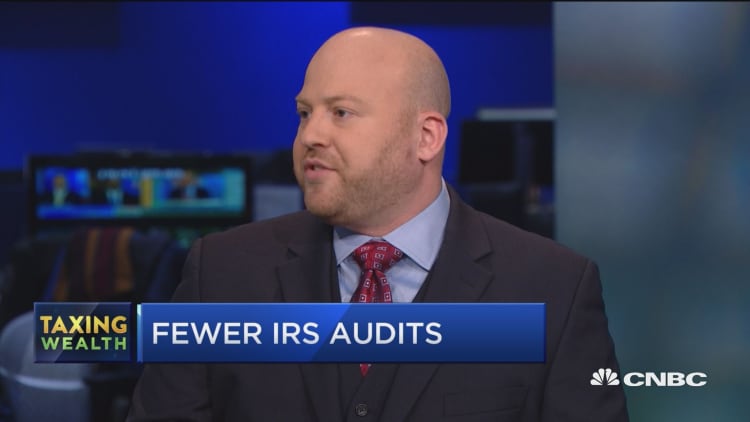Tax season is prime time for catching and fixing last year's individual retirement account slip-ups.
Whether you put away too much money in your IRA or you forgot to take out a required minimum distribution — ie, a mandatory withdrawal — after you turned 70½, your accountant is likely to discover your mistakes.
"Missed RMDs are often caught now, while you're working with your tax preparer," said Tim Steffen, CPA and director of advanced planning at Robert W. Baird & Co.
More from Smart Tax Planning:
What taxpayers should know about the new Form 1040
Use your tax return to unearth your spouse's money secrets
Why the average tax refund is down 16 percent
"They'll say, 'You had an RMD last year, why not this year?' and that's when you realize you forgot," he said.
While IRAs are a valuable source of retirement income, the IRS can slap savers with penalties if they mess up the rules of how they work.
The good news is that you can get right with the taxman this spring. Here are a few common IRA mistakes and how you can fix them.
Missing RMDs
Of all IRA mistakes, missing that RMD after you've turned 70½ might be one of the most costly oversights.
Savers have until the end of the year to make this withdrawal. If you have multiple retirement accounts, including a traditional IRA and a 401(k), then each is subject to a required distribution.
Fail to take the RMD, and you could get a 50 percent tax penalty on the withdrawal you should have made.
Here's the good news: The IRS might waive the penalty if you catch your mistake early and fix it.
"If you correct it right away and take the distribution out, you can request a waiver of the penalty on your tax return," said Steffen.
Missed RMDs are often caught now while you're working with your tax preparer.Tim SteffenCPA and director of advanced planning at Robert W. Baird & Co.
First, take the missed RMD as soon as soon as possible.
As you prepare your taxes, file Form 5329, which spells out the so-called "excess accumulations tax" or the penalty that applies to missed distributions.
Finally, attach a letter of explanation, telling the IRS that you made up the missed distribution and explaining why you failed to take the withdrawal last year, said Ed Slott, CPA and founder of Ed Slott and Co.
Tax geeks might be familiar with the qualified charitable distribution — a tax-efficient strategy that allows you to transfer money from an IRA to a qualifying charity in lieu of an RMD. Be aware that you can't apply this tactic to a missed distribution.
"You can only do the qualified charitable distribution for 2019, and not last year," said Slott.
Excess contributions
When it comes to Roth IRAs and traditional IRAs, there is such a thing as saving too much.
For 2018, savers are able to contribution up to $5,500 in an IRA or Roth IRA in total. If you're over 50, you can kick in up to $6,500.
Excess contributions are subject to a penalty tax of 6 percent each year.
It's pretty easy for savers to save too much money in these accounts.

For instance, maybe you saved $5,500 in your IRA last year, forgot about it and made another contribution just prior to filing your taxes this spring.
Indeed, Jan. 1 through April 15 is a period when savers can put money in an IRA and have it count for either 2018 or 2019.
Or maybe you've been contributing to a Roth IRA, but last year you had a raise. As a result, your modified adjusted gross income went over $120,000 if single or $189,000 if married and filing jointly.
Savers with MAGI over those thresholds in 2018 are unable to directly contribute the full $5,500 to their Roth IRAs. If they make the contribution anyway, the penalty may apply.
Claw back your excess
The best course of action if you've put too much money in your IRA or Roth IRA is to take the excess contribution out immediately, said Steffen.
If you withdraw the extra cash and the earnings prior to the due date of your tax return, you can avoid the 6 percent penalty.
Earnings that have accumulated on the excess contribution will be subject to taxes, and you might pay a 10 percent early withdrawal penalty.
The alternative is that you can leave the cash in and reduce your 2019 contribution by the amount of extra money you put into the account.
For instance, let's say you were limited to a $5,500 contribution for 2018, but you had put in $6,500. You can carry forward the excess $1,000 to 2019, pay the 6 percent penalty, and then limit your IRA contribution for that year.
That means instead of contributing the 2019 max of $6,000 ($7,000 if you're 50 and over) to your IRA, you would reduce your contribution for this year by $1,000 to account for the excess you had paid earlier.
"You leave the money in the account, pay the penalty for the prior year and then treat it as a contribution for the next year," said Steffen.





